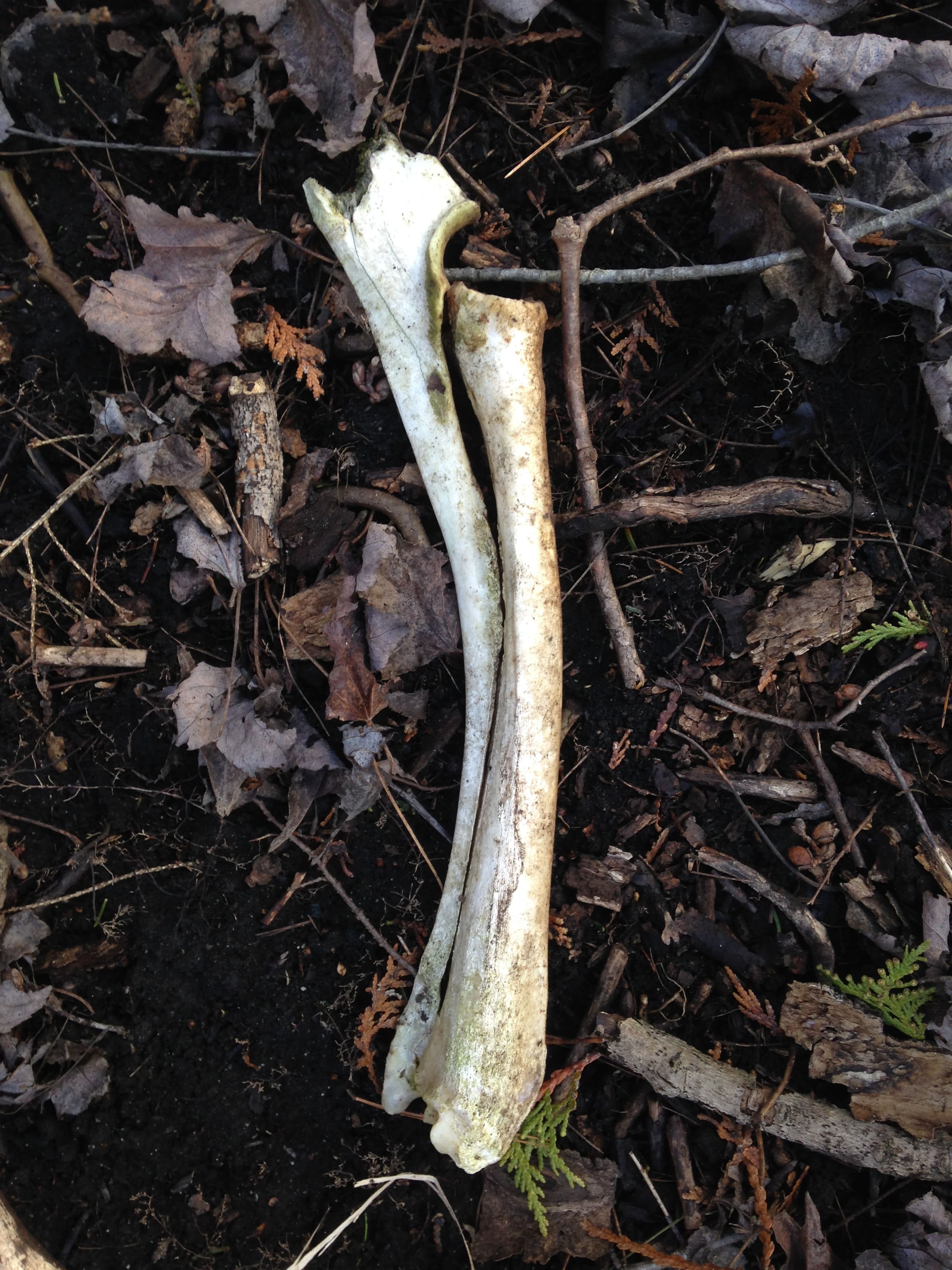What bones did we find?
I went for a walk with my partner and we found a bunch of cool things while we were out, like Yellow Birch (Betula allenghaniensis) seeds, lots of White-tailed Deer (Odocoileus virginianus) scat, all sorts of neat lichens, and also a couple of bones, which based on their size were most likely from the White-tails.
The first bones I found were pretty interesting, quite a good length and size. It was also cool because it seemed like two bones fused together. I figured this would be a simple bone to figure out where it was from on this other animal, and I figured I should learn more about what purposes this bone supports.
This photo shows the bright side of the bone which was bleached by the sun.
When I got home I looked it up and learned that it was the radius and ulna, which I remember learning about in my training to be a PSW (personal support worker/nurses aide) back in the day. I remember the radius and ulna being in the forearm and helping the arm to rotate around the wrist allowing the palm to face up or down (supination and pronation). The radius rotates over top of the ulna when turning the palm from the supinated position (palm facing up) to the pronated position (palm facing down).
Now do the radius and ulna do the same thing for Deer? Can they supinate their metacarpals and hooves? Because the radius and ulna are fused, I don’t think they can. It would be an advantage to not be able to turn your feet around as much; fewer to no twisted ankles. But really I am unsure. I haven’t seen a deer turn their legs around like we can with our hands. The next time I find a deer carcass, I’ll have to try to supinate the forelimbs to see if and how they work.
To orient a little to the photograph, the proximal end of the bone (the part closest to the main trunk or body of the Deer) is at the top, while the distal end (part furthest from the trunk or main body of the animal) is at the bottom of the image. The proximal end articulates with the humerus bone, while the distal end meets up with the metacarpal. The eminence (sticky outty bit of bone) at the proximal end of the ulna is called the olecranon and this is the equivalent to our own elbow.
Can I tell left front or right front legs just by looking at this photo? No, I can’t, and I really didn’t spend enough time with the bone, nor have the questions to know what to look for when we came across it.
This photo shows the side of the bones which were against the soil.
The other bone I found was only a couple of meters away. It was broken in half and the unbroken end reminded me of the scroll of a violin (the swirly bit at the tip of the head near where the tuning pegs are).
This was a helpful aspect to remember as when I got home and looked it up, that was a key identifier. This bone is the humerus, sometimes called the funny bone. The orientation of the photograph shows the distal part (again furthest from the trunk of the Deer) at the top of the image, with the proximal part (closest to the body of the Deer) missing as the bone was broken in half, but the break is visible at the bottom of the image. The scrollish bit at the top of the photo is where the humerus articulates with the ulna and radius. At the other end, the broken off end, includes the head of the humerus, which is the part that articulates with the scapula, one of my favorite bones to find.
I like to bring bones home to further study once in a while, but if you look near the break at the bottom of the photo there are some visible chews from a rodent of some kind who has fed on this bone for the minerals. There is plenty of good bone left and the other animals likely need the bone more than I do.
Sometimes coming across a little mystery can teach us a lot about ourselves and what makes up our bodies. We can learn what we have in common with other animals and recognize ourselves in them, and a little of them in ourselves. It also helps us to see where we are different and see what special adaptations we all come with.
I want to recognize that this post was made possible as result of a gift I received for my birthday from my partner, my brother and a couple of friends chipping in to purchase an expensive book for me. “Human and Nonhuman Bone Identification : A Color Atlas” by Diane L. France is an amazing book with lots of photos showing various details of commonly found bones across many different species. I am constantly finding bones so it is a very helpful book to now own. Thanks to everyone who chipped in to get me this great gift.



